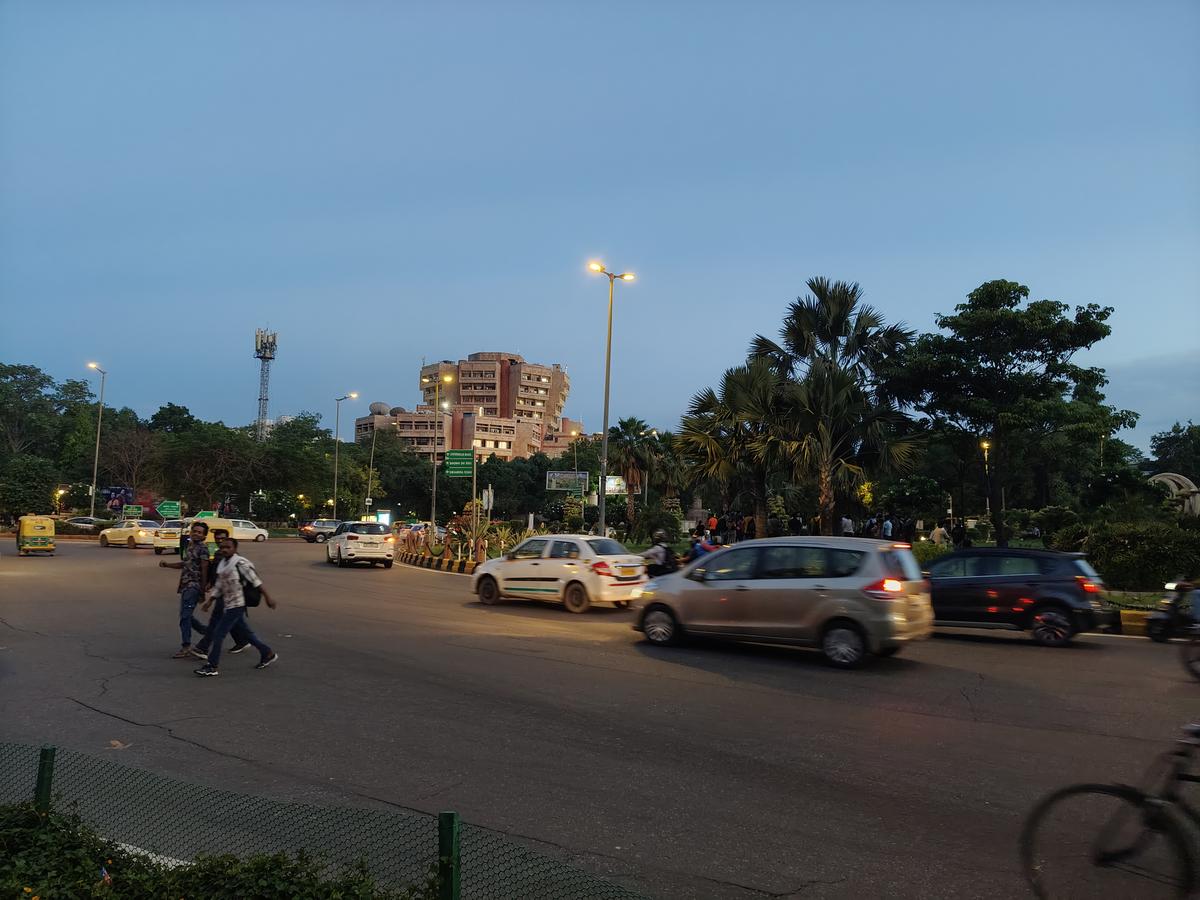Building on the success of Realme 12 Pro, this new model introduces key upgrades in performance and photography. The phone now features an upgraded processor – Snapdragon 7s Gen 2, and an improved 50 MP Sony LYT-600 main camera with OIS. Realme is also emphasising on AI capabilities with its new HYPERIMAGE+ architecture, promising enhanced photography and overall improved performance.
Design
While we were fond of the faux leather finish on the Realme 12 Pro, the 13 Pro takes a different approach that’s no less striking. Our review unit came in the Monet Purple variant, which is a result of Realme’s collaboration with the Museum of Fine Arts in Boston. This Claude Monet-inspired colour scheme is truly eye-catching, featuring a wavy pattern on the rear that adds a touch of elegance and artistic flair.
Realme 13 Pro
| Photo Credit:
Haider Ali Khan
The phone feels good in your hand, with a lightweight build that belies its premium feel. The button placement remains intuitive, with the power button and volume rocker easily accessible on the right side. At the bottom, you’ll find the USB-C port, speaker grille, and SIM tray.
The camera island maintains a similar design to its predecessor, providing a sense of continuity in Realme’s design language. The phone also comes with an IP65 rating for dust and water resistance, adding a layer of durability to its stylish exterior.
(For top technology news of the day, subscribe to our tech newsletter Today’s Cache)
Display
The Realme 13 Pro features a 6.7-inch OLED display with a resolution of 2412 x 1080 (FHD+). With a screen-to-body ratio of 93%, the phone offers an immersive viewing experience. The bezels on the screen are very thin, adding to the viewing experience that also supports a 120 Hz refresh rate.
Colour reproduction is excellent, with support for 1.07 billion colours and 100% coverage of the DCI-P3 colour gamut. The display can reach a typical brightness of 600 nits, with a global maximum of 1200 nits and a local peak brightness of 2,000 nits, ensuring good visibility even in bright outdoor conditions.
OS
The Realme 13 Pro runs on Realme UI 5.0, based on Android 14. This latest iteration of Realme’s custom skin offers a clean, user-friendly interface with a host of customisation options and features.
Processor
The new Realme 13 Pro is powered by the Snapdragon 7s Gen 2 chipset, a step up from its predecessor. This 4nm octa-core processor, clocked at up to 2.4 GHz, paired with the Adreno 710 GPU, delivers solid performance across the board.
In our testing, we encountered no noticeable lags or stutters during day-to-day use. The phone handles multitasking with ease, switching between apps smoothly. While it may not be designed for intense gaming sessions, the Realme 13 Pro performs admirably with moderate gaming loads, offering a stable frame rate and manageable temperatures during extended play sessions.
The Realme 13 Pro comes in multiple configurations to suit different needs and budgets. RAM options include 8 GB and 12 GB. As for storage, users can choose from 128 GB, 256 GB, or 512 GB variants. Our review variant came in the configuration of 12 GB/512 GB.
The Realme 13 Pro achieved a single-core score of 876 and a multi-core score of 2506. The GPU score came in at 1756. The figures recorded are very average. Additionally, in our AnTuTu benchmark, the phone recorded a score of 65633.
Camera
The camera system on the Realme 13 Pro is one of its standout features. The main camera is a 50 MP Sony LYT-600 sensor with optical image stabilization (OIS). This 1/1.95 inch sensor, coupled with an f/1.88 aperture lens, captures impressive detail and dynamic range in various lighting conditions.
The main camera produces vibrant, well-exposed images with excellent colour reproduction. The OIS helps reduce motion blur, resulting in sharper images even in slightly challenging lighting conditions. Portrait mode leverages the sensor’s capabilities to create a natural-looking bokeh effect, with good edge detection around the subject.

Realme 13 Pro camera sample
| Photo Credit:
Haider Ali Khan
The secondary sensor is an 8 MP ultra-wide camera, with its 112° field of view, allowing you to capture more of the scene. While it doesn’t match the main sensor in terms of detail, it performs well in good lighting conditions, maintaining consistent colour science with the primary camera.
Low-light performance has seen notable improvements, thanks in part to the larger sensor and OIS. Night mode images show good detail retention and noise control, though some softening is noticeable upon close inspection.

Realme 13 Pro camera sample
| Photo Credit:
Haider Ali Khan
The 32 MP Sony selfie camera delivers pleasing self-portraits with natural skin tones and good detail. The wide 90° field of view is great for group selfies or capturing more of your background.
One of the exciting new features is the AI Ultra Clarity mode, which is currently in its beta phase. This AI-powered feature does an impressive job of enhancing image quality by applying intelligent touch-ups. In our testing, we found that it noticeably improves overall image quality, enhancing details and optimising colour balance.
Battery
The battery capacity has seen a slight bump from 5,000 mAh in the 12 Pro to 5,200 mAh in the 13 Pro. This larger battery, combined with the efficient Snapdragon 7s Gen 2 chip, provides excellent battery life that easily lasts through a full day of moderate to heavy use.
Charging speeds, however, have seen a downgrade from the 67 W charger in the 12 Pro to a 45 W SUPERVOOC charger in the 13 Pro. While not as blazingly fast as its predecessor, it still provides relatively quick charging times, getting you from empty to full in about an hour.
Verdict
The Realme 13 Pro successfully builds upon its predecessor’s foundation. Starting at ₹23,999, the Realme 13 Pro enters one of the most competitive segments of the Indian smartphone market, facing strong contenders like the Motorola Edge 50 Fusion and Nothing Phone 2a.
However, its balance of performance, camera capabilities, and distinctive design make it a worthy consideration for those seeking a well-rounded mid-range device.




